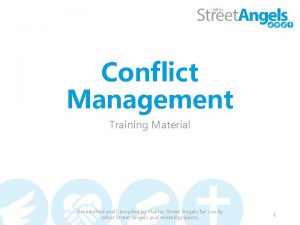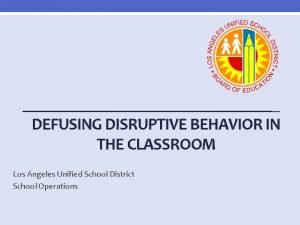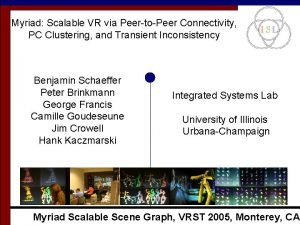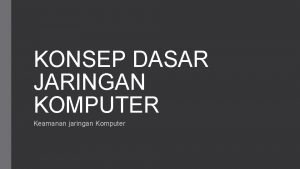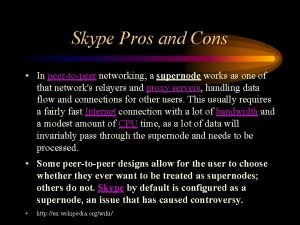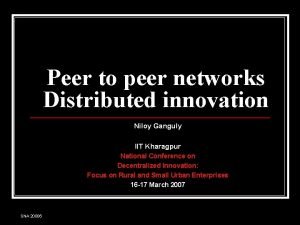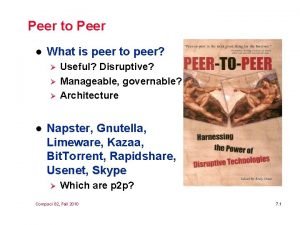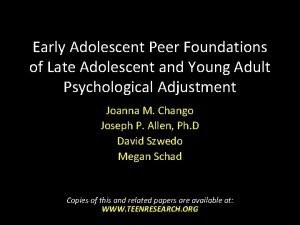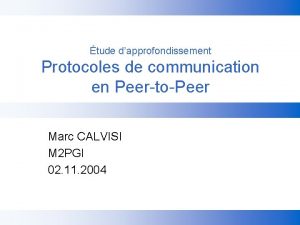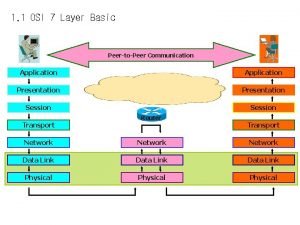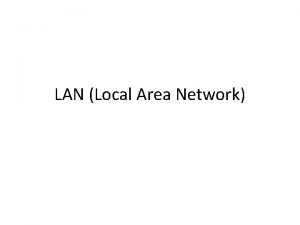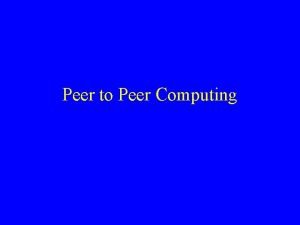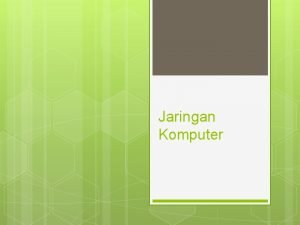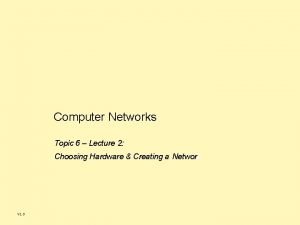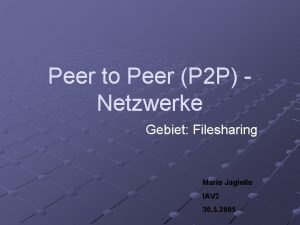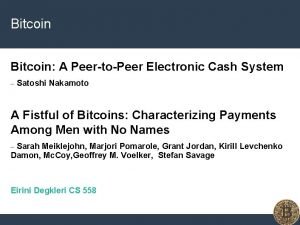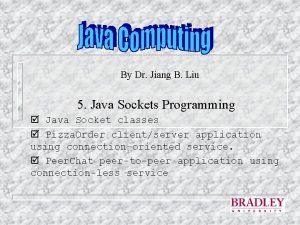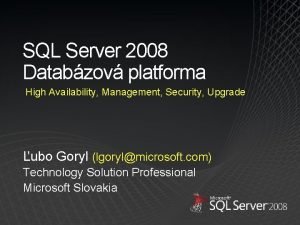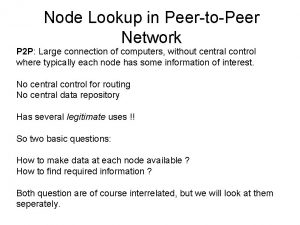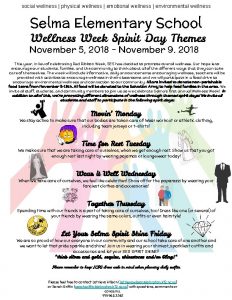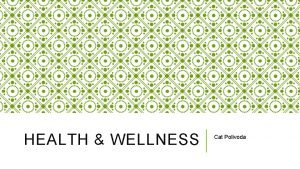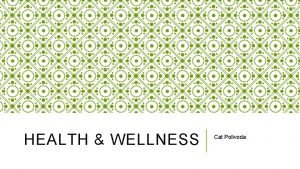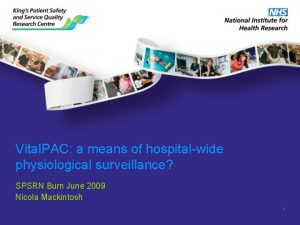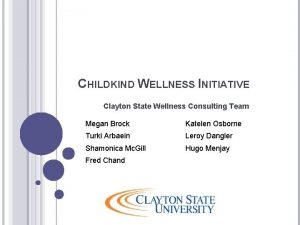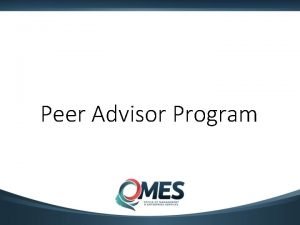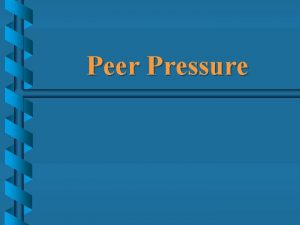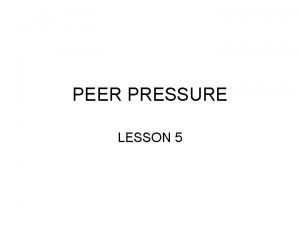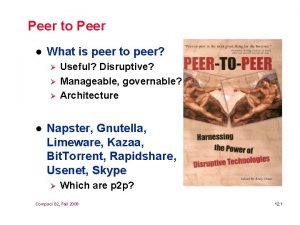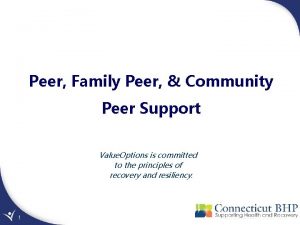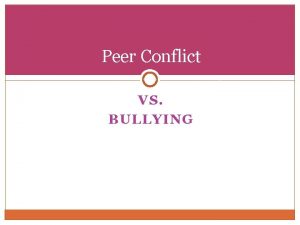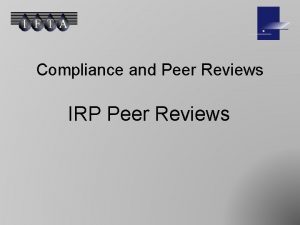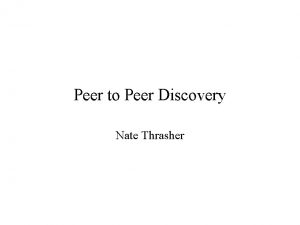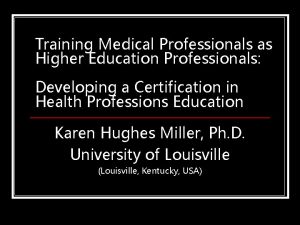Peer Defusing HospitalWide Wellness Initiative for Medical Professionals























































- Slides: 55

Peer Defusing: Hospital-Wide Wellness Initiative for Medical Professionals’ Compassion Fatigue Prevention and Stress Reduction Dr. Melissa Arthur, Ph. D, LMFT, LCSW Director, Behavioral Science St. Joseph’s Hospital Family Medicine Residency Assistant Professor, SUNY Upstate Medical University Departments of Family Medicine and Psychiatry Dr. Christopher David Kowal, BS, MSN-MOL-Ed, DNP, RN, CCRN-CMC-CSC St. Joseph’s Hospital Health Center Clinical Nurse Leader for Relationship-Based Care and Shared Governance Adjunct Professor of Nursing, American Sentinel University Yih-hsing Liu, MS-Ed Syracuse University Syracuse, NY 13203 The 33 rd Forum for Behavioral Science in Family Medicine "Promoting Well-being and Reflection among Medical Professionals“ Chicago, IL 60611 September 29, 2012

Objectives Following this presentation, participants will be able to: Define the process of Peer Defusing Identify the dual components in the feedback process List the three benefits for utilization of peer defusing

Introduction Stress impacts the healthcare profession with rates of social, chemical, and physical abuse that are considerably higher than within other professions (Department of Health and Human Services [DHHS], 2008) Higher rates of anxiety & depression are related to job stress (DHHS, 2008)

Bottom line: Psychological distress exists in the healthcare workplace Including but not limited to: burnout, absenteeism, employee intent to leave, reduced patient satisfaction, and diagnosis and treatment errors (DHHS, 2008)

Workplace stress has been found to profoundly impact nursing and physician practice as well as other healthcare professions and ancillary supports (de Carvalho, Muller, & Bachion, 2005; Millikan, Clements, & Tillman, 2007) Dealing or coping with acute or chronic, on -the-job stressors has been considered part of the “expected” job role of care providers (such as medicine and nursing) since their respective inceptions (de Carvalho et al. , 2005; Hall, 2004; Yoder, 2010)

A standardized and reproducible approach to stress management across the multiple healthcare specialties may benefit professional development and co-worker survival A common approach to addressing stress in any healthcare setting may benefit mankind

Problem Statement Stress occurs regularly in the hospital setting Resuscitations, rapid responses, and patient deaths What about the silent grip of unexplained and debilitating problems like depression, obesity, immune disorders, addiction, or anxiety that could be suggestive of fallout from “vicarious trauma? ” (Izzo & Miller, 2011) A model of “peer defusing” offers a consistent method of intervention for stress management at the staff level…. So. . . HOW DOES IT WORK? ?

What is Peer Defusing? Group intervention immediately following a stressful event for those involved Informal appraisal Psychosocial support Opportunity for discussion and expression Education regarding coping, process, and outcomes (Everly & Mitchell, 1997) Goal: Psychological first aid and performance improvement


Literature Review Stressors: Awareness Recognition Identification Frequently ignored in the hospital setting or regarded as “part of the job”

Review Stress occurs in hospitals on a regular basis (Epstein, Burns, & Conlan, 2010) Patient workloads, shift assignments, rotating shifts, overtime coverage and on-call, and floating to different units or covering sub-specialties (Epstein et al. , 2010) Workforce shortage (DHHS, 2010) Non-critical stressors Patient deaths (anticipated or unexpected), emergency responses, and unforeseen adverse healthcare practice situations or outcomes like patient falls Difficult patients and families

Outcome Proposed Solution: Peer defusing has been implemented at St. Joseph’s Hospital Health Center (SJHHC) to aid employees in handling and coping with stressful situations so that they may be able to better cope and continue to optimally function in their job-roles

Purpose Examine current state of peer defusing within SJHHC and its perceived impact on staff within the organization Exploration of this phenomenon Help further describe its existence, utilization, and impact on healthcare workers as well as aid in guiding future research initiatives

Significance Provide general, foundational knowledge and understanding of the phenomenon and effects on healthcare workers Potential to suggest and guide future practice Lay the groundwork for proceeding with future studies

Design Single-subject case environment at the organizational level (Yin, 2008) Descriptive and explorative Mixed Study Qualitative review of data sources from interviews and analysis of secondary quantitative data To understand a particular phenomenon in the context of its meaning for an organization and its participants (Creswell, 2002; Yin, 2008)

Design-cont’d Quantitative analysis: Secondary analysis of SJHHC hospital staff survey data to explore potential relationships among pre-identified factors of importance as well as impact of the peer defusing program


Research Question “What was the nature of the phenomenon of peer defusing in St. Joseph’s Hospital Health Center (SJHHC), and how did it affect employees exposed to it? ” Case study Explored and described the peer defusing model as it existed in the SJHHC workplace following its implementation since June 2011 Examined how it impacted the culture of hospital employees

Method Case Study Described the phenomenon of peer defusing Described actual circumstances in which peer defusing occurred Explored the observed, perceived, and reported outcomes Discovered potential associations between the phenomenon of interest and staff perceptions within SJHHC (Tellis, 1997; Yin, 2008) Mixed methods approach

Setting St. Joseph’s Hospital Health Center 431 -bed, acute care hospital in Syracuse, NY

Sources of Evidence Qualitative: 23 Semi-structured interviews Quantitative: Secondary correlation analysis of stress management survey data (n = 530)

Qualitative Procedure: Subject Interviews Semi-structured interview Understand participants’ experiences of peer-defusing, both formally and informally 5 questions were asked of 23 subjects Approximately 45 -60 minutes of semi-structured interview was conducted. Probes were conducted when investigators identified narrations related to the research questions All interviews were audio-taped and transcribed

Interview Questions When you first heard about peer defusing what was your reaction? What was it like for you when you participated in a peer defusing? What benefits exist with peer defusing? What barriers or challenges exist with peer defusing? Is there anything else you would like to share about your experience with peer defusing?

Qualitative Data Source Review Method of theme emergence: 3 steps to analyze the data Individual investigator coding Collaborative code grouping and pattern identification by investigators Theme grouping

Qualitative Results 6 Major Themes Identified: Theme 1: Stressful incidents remain as residuals for individuals in the healthcare setting Theme 2: Supportive informal and formal peer defusing affects individual well-being, performance, and job satisfaction Theme 3: Peer defusing suggests prevention of adverse effects from the experience of stressful incidents Theme 4: Peer defusing suggests a perceived increase in healthcare worker morale, bonding, and connection Theme 5: Time, resource availability, fear, and status affect the decision to utilize peer defusing Theme 6: There is a perceived need to provide a more formalized process of peer defusing. Formal defusing and debriefing increased with criticality of stressful incident

Qualitative Exemplars Theme 1: Stressful incidents remain as residuals for individuals in the healthcare setting “If a nurse is upset, if she feels attacked or angry or frustrated, it’s going to take away from her focus on the patient. ”

Exemplars-cont’d Theme 2: Supportive informal and formal peer defusing affects individual well-being, performance, and job satisfaction “It validates the emotional piece so you do not have to take it home with you. ” “…it would have just nagged at me” “If individuals become walled up they are more likely to become burnt out. ”

Exemplars-cont’d Theme 3: Peer defusing suggests prevention of adverse effects from the experience of stressful incidents “Until it explodes or you know, like if I have resentment towards you because I don’t understand what you did weeks ago and then something happens and you blow up. ” “[Example: ] I had a bad day today. I'm not going in tomorrow. I think peer defusing will help with lower absenteeism. ”

Exemplars-cont’d Theme 4: Peer defusing suggests a perceived increase in healthcare worker morale, bonding, and connection “…reduce or eliminate the possibility of feeling isolated and alone. ” “…verbalizing that in and of itself in a room full of people, all of us who had similar feelings to that or most of the people in the room expressed feelings similar to mine that made a difference. ”

Exemplars-cont’d Theme 5: Time, resource availability, fear, and status affect the decision to utilize peer defusing “I just think the bigger barrier is that people are just tired and busy. ” “We are just so busy doing our jobs we usually do not stop to think about how we are doing. ” “When it comes to sharing emotions, people become a little ‘heebie jeebie-ish. ’”

Exemplars-cont’d Theme 6: There is a perceived need to provide a more formalized process of peer defusing. Formal defusing and debriefing increased with criticality of stressful incident “We need to teach peer defusing right from day one. And I don’t see that in our curriculum right now. I’m sure it’s in there, but it’s not worded that way. ” “I do think in order to implement a new process, staff have to understand why it’s being implemented rather than just OK, here’s something else we’re being told to do. ” “…when it was the formal time…verbalizing in a room full of people…expressed feelings similar to that-made a difference. ”

Quantitative Procedure: Secondary Analysis of Stress Management Survey Employee Stress Management Survey (SMS’ 12) distributed to hospital staff 6 -months following formal implementation of network-wide peer defusing initiative (January 2012) 530 responses

SMS’ 12 Survey Questions 1. I have been involved in stressful work-related situations since June 2011 2. Immediately following the experience of a stressful situation at work, the opportunity to participate in a group discussion was offered to me: either a formal discussion led by a facilitator or an informal, peer-driven discussion 3. I have shared personal feelings/reflections with other staff related to stressful situations at work 4. I have participated in healthcare team discussions after a stressful event 5. Sharing personal feelings/reflections with other staff regarding work-related situations has made me feel less stressed

SMS’ 12 -cont’d 6. As a result of experiencing stressful incidents at work since June 2011, I have considered changing job roles/departments within this institution 7. I feel this institution has offered adequate staff-support since June 2011 to cope with stressful events 8. Experiencing stressful situations at work these past 6 -months has caused me to consider leaving my current place of employment 9. I was offered a peer defusing but chose not to participate 10. I participated in a peer defusing but did not participate in the follow -up process through the Employee Health Office 11. I participated in a peer defusing and also participated in the -up process through the Employee Health Office follow

SMS’ 12 Directions Based on your personal reflections since June of 2011, please use the Likert scale below to honestly answer the following questions regarding your experiences and feelings following stressful work events: patient deaths, cart calls, rapid responses, difficult patient/family situations, staff issues, or other stress-related work situations LIKERT SCALE: 1 = Never, 2 = Very Rarely, 3 = Rarely, 4 = Occasionally, 5 = Very Frequently, 6 = Always

SMS’ 12 -cont’d Pearson Correlation Matrix STRESS GROUP SHARE TEAMDISC LESSTRESS CHANGE SUPPORT STRESS 1. 000 GROUP 0. 002 1. 000 SHARE 0. 283* 0. 265* 1. 000 TEAMDISC 0. 009 0. 642* 0. 351* 1. 000 LESSTRESS -0. 042 0. 325* 0. 449* 0. 290* 1. 000 CHANGE 0. 381* -0. 223* 0. 134* -0. 158* -0. 165* 1. 000 SUPPORT -0. 260* 0. 514* 0. 093* 0. 468* 0. 343* -0. 344* 1. 000 LEAVE 0. 414* -0. 244* 0. 125* -0. 182* -0. 152* 0. 824* -0. 326* LEAVE 1. 000

SMS’ 12 -cont’d Relationships r(528) p 1. Experiencing workplace stress & sharing personal feelings with others . 28 . 00 2. Experiencing workplace stress & desire to change job roles . 38 . 00 3. Experiencing workplace stress & perceived organizational support -. 26 . 00 4. Experiencing workplace stress & desire to leave organization outright . 41 . 00 5. Opportunities to participate group discussion & sharing personal feelings . 27 . 00 6. Opportunities to participate group discussion & actual participation . 64 . 00 7. Opportunities to participate group discussion & feeling less stressed after sharing . 33 . 00 8. Opportunities to participate group discussion & desire to change job roles -. 22 . 00 9. Opportunities to participate group discussion & perceived organizational support . 51 . 00 10. Opportunities to participate group discussion & desire to leave -. 24 . 00 11. Sharing personal feelings regarding stressful incidents & participating in healthcare team discussions . 35 . 00 12. Sharing personal feelings regarding stressful incidents & feeling less stressed . 45 . 00 13. Sharing personal feelings regarding stressful incidents & desire to change job roles . 13 . 00 14. Sharing personal feelings regarding stressful incidents & perceived organizational support . 09 . 03 15. Sharing personal feelings regarding stressful incidents & desire to leave . 13 . 00

SMS’ 12 -cont’d Relationships r(528) p 16. Participation in team discussions & feeling less stressed . 29 . 00 17. Participation in team discussions & desire to change job roles -. 16 . 00 18. Participation in team discussions & perceived organizational support . 47 . 00 19. Participation in team discussions & desire to leave -. 18 . 00 20. Feeling less stressed after sharing personal feelings following stressful incidents & desire to change job roles -. 17 . 00 21. Feeling less stressed after sharing & perceived organizational support . 34 . 00 22. Feeling less stressed after sharing & desire to leave -. 15 . 00 23. Desire to change job roles following stressful incidents & perceived organizational support -. 34 . 00 24. Desire to change job roles & desire to leave . 82 . 00 25. Adequate organizational stress management support and desire to leave -. 33 . 00

SMS’ 12 -cont’d Desire to change job roles & desire to leave: r(528) =. 82, p =. 00 Following stressful incidents at work, as desire to consider changing job roles increased, so did the desire to consider leaving the organization outright Opportunities to participate group discussion & actual participation: r(528) =. 64, p =. 00 Following stressful incidents at work, as opportunities offered to staff to participate in group discussion increased, so did actual staff participation in these discussions

SMS’ 12 -cont’d Opportunities to participate group discussion & perceived organizational support: r(528) =. 51, p =. 00 Following stressful incidents at work, as opportunities offered to staff to participate in group discussion increased, so did staff perceptions that the organization offered adequate stress management support

Quantitative Interpretation Workplace stress impacted desires to consider job role change and leaving the hospital Felt lack of organizational support However, increased sharing suggested alleviation of these feelings

Opportunities to defuse (team discussions, group discussions, or individual discussions) increased likelihood in participation and sharing Peer Defusing (PD) decreased stress and desire to change job roles or leave the organization Growing perception: better organizational support regarding stress management

Comparison of Results Qualitative Stressful incidents: Residuals for staff Quantitative Stress: Change job roles, leave; lack of support Support (informal and formal): Affects individual Sharing impacted feeling less stressed well-being, performance, and job satisfaction Peer Defusing (PD): Prevention of adverse effects from the experience of stressful incidents PD: Staff felt less stressed and greater organizational loyalty PD: Increase in healthcare worker morale, bonding, and connection Offers to PD suggested increased participation and shared discussion Time, resource availability, fear, and status affect the decision to utilize PD PD: Increased offerings suggested greater utilization of process Perceived need to provide a more formalized PD process of : Formal defusing and debriefing increased with criticality of stressful incidents Feelings of increased organizational support

Interpretation Organization: Operational Peer defusing: New, infancy stage of development Process of enculturation and habituation through participation (Tirosh, 1999) Knowledge mobilization (Maibach, Van Duyn, & Bloodgood, 2006) Adoption as a form of routine practice (Rogers, 2003) Viewed as a positive form of stress management Owned by the organization Supported but not consistent

Interpretation-cont’d Individual: Functional Stress affects job loyalty and organizational attrition Discussing stressful events and personal feelings in a shared environment impacts the employee-loyalty perception and suggests a reduction in personal stress levels Participation in PD suggests improved outcomes for healthcare workers

Interpretation-cont’d Implementation and upkeep of social support networks within the healthcare workforce have been suggested to lead to improved satisfaction and increased retention rates (Mac. Phee & Scott, 2002) The greater use healthcare staff found in peer defusing when applicable, the greater the potential benefits could be for them

Interpretation-cont’d Challenges Global awareness Consistency in support and implementation Time

Interpretation-cont’d Theory of Impact of Peer Defusing Established an operational description of the phenomenon that may be used as a working foundation for future development in organizational stress management technique (Stanley, 2001; Treister, 2003) Process is indeed a beneficial model of stress management for SJHHC hospital employees The concept of facilitated group or individual discussions following stressful incidents was suggested to decrease staff stress levels and similarly imply better feelings of job satisfaction with regard to a decreased desire to change job roles or leave the organization In order for this practice model to be better evaluated and tested for success and statistical significance, it needs to first be more strongly enculturated within the organization

Limitations Size: Single organization-decreases external validity Lack of psychometricity of survey Participants were self-selected increasing potential bias

Future Recommendations Within SJHHC: Further study and measurement: Replication, larger respondent pool, diversify resident, attending, and staff nursing levels Quantitative measurement Routine measurement tool (development) for outcomes Study elements of program that were impactful versus those that were not

Beyond SJHHC: Replicate outside SJHHC (multisite) Larger sample sizes and stratification Continued study of the effects of peer defusing with wide dissemination of the results Examine outcome data - retention, absenteeism, Test the survey’s psychometrics

After All… Improvement in staff satisfaction, reduction in feelings of job stress, and increased workplace loyalty could strongly impact the perpetuation of better healthcare practice and patient outcomes

References de Carvalho, E. C. , Muller, M. , & Bachion, P. (2005). Stress in the professional practice of oncology nursing. Cancer Nursing, 28(3), 187− 192. Retrieved from EBSCOhost database. Everly, G. S. , Jr. , & Mitchell, J. T. (1997). Critical incident stress management (CISM). A new era and standard of care in crisis intervention. Ellicott City, MD: Chevron Publishing. Hall, D. (2004). Work-related stress of registered nurses in a hospital setting. Journal for Nurses in Staff Development, 20(1), 6− 14. Retrieved from EBSCOhost database. Izzo, E. , & Miller, V. C. (2011). Second-hand shock: Surviving and overcoming vicarious trauma. Scottsdale, AZ: High Conflict Institute Press. Mac. Phee, M. , & Scott, J. (2002). The role of social support networks for rural hospital nurses: Supporting and sustaining the rural nursing work force. Journal of Nursing Administration, 32(5), 264 -272. doi: 10. 1097/00005110 -200205000 -00006 Maibach, E. W. , Van Duyn, M. A. , & Bloodgood, B. (2006). A marketing perspective on disseminating evidence-based approaches to disease prevention and health promotion. Preventing Chronic Disease, 3(3), A 97. Retrieved from Pub. Med databse. Millikan, T. F. , Clements, P. T. , and Tillman, H. J. (2007). The impact of stress management on nurse productivity and retention. Nursing Economics, 25(4), 203210. Retrieved from Medscape database. Rogers, E. M. (2003). Diffusion of innovations (5 th ed. ). New York, NY: Free Press.

References-cont’d Stanley, T. L. (2001). Burnout: A manager’s worst nightmare. Supervision, 62(8), 3 -5. Retrieved from http: //eresources. lib. unc. edu Systat Software, Inc. (2008). Mystatistical analysis software. Chicago, IL: Author. Retreived from http: //www. systat. com/Default. aspx Tellis, W. (1997). Application of a case study methodology. The Qualitative Report, 3(3). Retrieved from http: //www. nova. edu/ssss/QR/QR 3 -3/tellis 2. html Tirosh, D. (1999). Forms of mathematical knowledge: Learning and teaching with understanding. Norwell, MA: Kluwer Academic Publishers. Treister, N. W. (2003, July). Workplace stress affects employees’ overall health. San Diego Business Journal, 24, 18 -19. Retrieved from EBSCOhost database. US Department of Health and Human Services. (2008). Exposure to stress: Occupational hazards in hospitals. Cincinnati, OH: Centers for Disease Control and Prevention, National Institute for Occupational Safety and Health. Available from http: //www. cdc. gov/niosh/ docs/2008 -136/pdfs/2008 -136. pdf Yin, R. K. (2008). Case study research: Design and methods (4 th ed. ). Thousand Oaks, CA: Sage Publications. Yoder, E. A. (2010). Compassion fatigue in nurses. Applied Nursing Research, 23(4), 191 -197. doi: 10. 1016/j. apnr. 2008. 09. 003

Thank You !
 Defusing vaiheet
Defusing vaiheet Defusing dog
Defusing dog What does palms stand for in conflict resolution
What does palms stand for in conflict resolution Defusing disruptive behavior in the classroom
Defusing disruptive behavior in the classroom Relazione finale docente tutor compilata
Relazione finale docente tutor compilata Peer-to-peer o que é
Peer-to-peer o que é Annotazioni sulla verifica effettuata peer to peer
Annotazioni sulla verifica effettuata peer to peer Ambiti operativi da supportare
Ambiti operativi da supportare Konsep dasar jaringan komputer
Konsep dasar jaringan komputer Pros and cons of using skype
Pros and cons of using skype Peer-to-peer o que é
Peer-to-peer o que é Peer to peer l
Peer to peer l Peer-to-peer o que é
Peer-to-peer o que é Peer-to-peer
Peer-to-peer Peer-to-peer communication in osi model
Peer-to-peer communication in osi model Esempio registro peer to peer compilato
Esempio registro peer to peer compilato Jaringan peer to peer diistilahkan dengan
Jaringan peer to peer diistilahkan dengan Peer to peer computing environment
Peer to peer computing environment Peer to peer merupakan jenis jaringan… *
Peer to peer merupakan jenis jaringan… * Peer to peer network hardware
Peer to peer network hardware Tim beamer
Tim beamer Peer p
Peer p Sviluppo condiviso esempi di peer to peer compilati
Sviluppo condiviso esempi di peer to peer compilati Peer intervention program
Peer intervention program Features of peer to peer network and client server network
Features of peer to peer network and client server network Bitcoin: a peer-to-peer electronic cash system
Bitcoin: a peer-to-peer electronic cash system Peer to peer chat application in java
Peer to peer chat application in java Peer to peer transactional replication
Peer to peer transactional replication Node lookup in peer to peer network
Node lookup in peer to peer network Allied medical professions list
Allied medical professions list Network marketing health and wellness
Network marketing health and wellness Var 1721 för stormaktssverige
Var 1721 för stormaktssverige Densitet vatten
Densitet vatten Nationell inriktning för artificiell intelligens
Nationell inriktning för artificiell intelligens Tack för att ni har lyssnat
Tack för att ni har lyssnat Referatmarkeringar
Referatmarkeringar Tät skog karttecken
Tät skog karttecken Fimbrietratt
Fimbrietratt Magnetsjukhus
Magnetsjukhus Arkimedes princip formel
Arkimedes princip formel Tallinjen
Tallinjen Adressändring ideell förening
Adressändring ideell förening Elektronik för barn
Elektronik för barn Borra hål för knoppar
Borra hål för knoppar Smärtskolan kunskap för livet
Smärtskolan kunskap för livet Bris för vuxna
Bris för vuxna Mat för idrottare
Mat för idrottare Jiddisch
Jiddisch Etik och ledarskap etisk kod för chefer
Etik och ledarskap etisk kod för chefer Frgar
Frgar Ellika andolf
Ellika andolf Datorkunskap för nybörjare
Datorkunskap för nybörjare Blomman för dagen drog
Blomman för dagen drog Returpilarna
Returpilarna Rita perspektiv
Rita perspektiv Redogör för vad psykologi är
Redogör för vad psykologi är


